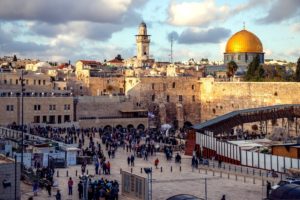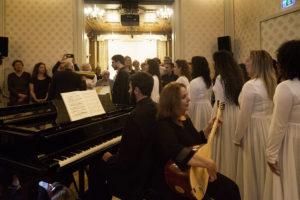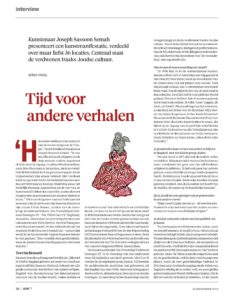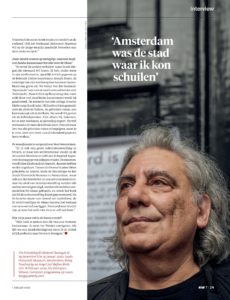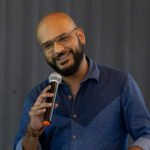Joseph Sassoon Semah, Henk Wijnen en Renée Hartog over de rol van de kunstenaar, vrijheid en engagement
In het kader van On Friendship/(Collateral Damage) III – The Third GaLUT; Baghdad, Jerusalem, Amsterdam was op 25 november 2019 vanuit Werkgebouw het Veem Amsterdam: Een gesprek tussen Joseph Sassoon Semah en Henk Wijnen over de rol van de kunstenaar, vrijheid en engagement, onder leiding van Renée Hartog, cultureel diplomaat.
Machteld Leij ~ Joseph Sassoon Semah in Museum De Domijnen
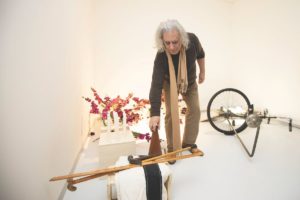
Joseph Sassoon Semah Being Touched by an Angel Just Before Birth tot 16 februari in Musem De Domijnen, Linge 5, Sittard
Hart – Alles over kunst. Nummer 200. De in Bagdad geboren joodse kunstenaar Joseph Sassoon Semah kwam in 1981 in Amsterdam wonen, na omzwervingen via Tel Aviv, Parijs, Londen en Berlijn. Van de meest prachtige, maar soms ook beladen materialen en vormen maakt hij installaties en geeft hij performances. Drijvende kracht in zijn symbolische werk is zijn eigen leven en de verdwenen joodse cultuur van het Midden-Oosten.
Dat kunstenaar Joseph Sassoon Semah (1948, Bagdad) niet altijd de aandacht kreeg die hij verdient, zou weleens kunnen komen door de religieuze onder- en boventoon in zijn werk. Religie ligt niet goed in de moderne kunst. Want die kunst zou rationeel en universeel moeten zijn. Maar Semah, joods en geboren in Bagdad, ziet dat heel anders. De moderne kunst barst van vormen die ten minste toch familiair zijn aan aspecten van joodse religie en geschiedenis. Het duidelijkste voorbeeld is het werk van Barnett Newman. Diens abstracte schilderijen met vlakken en banen zijn in Semahs ogen te vergelijken met de stroken op het witte gebedskleed van zijn grootvader, die opperrabijn was in Bagdad. Die blauwe stroken corresponderen met het abstracte werk van Newman, meent Semah. Hij verwerkt in zijn installatie NelLAH (The closing of the gates (Open closed) uit 1987 gebedsmantels, schildersdoek en deuren. Ernaast zette hij kartonnen dozen waarin ooit Blue Band, een margarinemerk, was verpakt.
In het rationele westen – in dit geval Nederland – is religie uit de kunst gefilterd. Maar Semah ziet, benadrukt en herijkt beeldelementen die terug te leiden zijn tot religie, tot de joodse traditie. Museum De Domijnen richtte Semahs overzichtstentoonstelling Being Touched by an Angel Just Before Birth in. Het vroegste werk stamt uit de jaren zeventig, het meest recente is van vorig jaar. De tentoonstelling is onderdeel van een langer lopend project, met performances en exposities in onder meer het Joods Historisch Museum. Waar andere kunstenaars nog weleens groeispurts doormaken, is het werk van Semah enorm consistent. Zijn installaties en tekeningen zijn tegelijk tijdloos en eigentijds. Als je niet naar de titels kijkt, zou je niet weten of een werk uit de jaren zeventig is, of dat het juist het atelier van de kunstenaar heeft verlaten.
De beelden die Semah maakt zijn voetnoten bij zijn teksten. Zijn materiaalgebruik is meesterlijk: zwaar geroeste vormen in cortenstaal zijn geometrisch, maar met hun roest ook een symbool van de verglijdende tijd. Glazen platen liggen gerangschikt volgens de plattegrond van een Duitse synagoge die tijdens de Kristallnacht werd vernietigd. Ze steunen op bronzen dingo’s. Honden zijn christelijk, associeert Semah, en dingo’s zijn bijzonder, omdat ze zich juist weer ontworsteld hebben aan de mensenwereld en opnieuw wild zijn geworden.
Lees verder: https://hart-magazine.be/expo/joseph-sassoon-semah-in-museum-de-domijnen
East-West GaLUT
Treatise on the Origin of Language
The more people invented, the more nomadic and separated they were when they invented, and yet for the most part invented only in a single circle for a single kind of things, then, when they afterwards came together, when their languages flowed into an ocean of vocabulary, the more synonyms! They could not be thrown away, all of them. For which should be thrown away? They were current with this tribe, with this family, with this poet. And so it became, as that Arab dictionary writer said when he had counted up 400 words for misery, the four hundredth misery [is] to have to count up the words for misery.
Treatise on the Origin of Language. Transl. by Michael N. Forester (Cambridge: Cambridge University Press), 117.
Goethe’s Study of Hebrew
From my Life: Poetry and Truth
I found an alphabet something like Greek, of which the forms were easy, and the names, for the most part, not new to me. All this I had quickly understood and learned, and supposed we should now begin to read. This, I was well aware, was done from right to left. But now, all at once appeared a new army of little characters and signs, of points and strokes of all sorts, which were in fact to represent vowels. At this I wondered the more, as there were manifestly vowels in the larger alphabet, and the others only appeared to be hidden under strange appellations. I was also taught, that the Jewish nation, so long as it flourished, had, in point of fact, been content with the first signs, and had known no other way of writing and reading. I should have liked very much to have gone on along this ancient, and, as it seemed to me, easier path; but my worthy instructor declared rather sternly, that we must be guided by the grammar in its generally accepted form. Reading without these points and strokes, he said, was a very difficult matter, and could only be undertaken by the learned, and the most highly trained scholars. […] At one time, it seemed, some of the primary and larger letters were to have no significance where they stood, simply that their little after-born kindred might not stand useless. At another time they were to indicate a gentle breathing, then a guttural, more or less harsh, or again they were merely pegs on which to hang the others. But, finally, when one fancied that one had taken in everything properly, some of these personages, both large and small, were made sleeping partners, and became inactive, so that one’s eyes always had very much, and one’s lips very little, to do.
Poetry and Truth. From my Own Life. Transl. by Minna Steele Smith, vol. 1 (London: George Bell & Sons 1908), 108-9.
Read more
Art Manifestation ‘On Friendship/(Collateral Damage) III – The Third GaLUT: Baghdad, Jerusalem, Amsterdam’ ~ The Guest Becomes Host
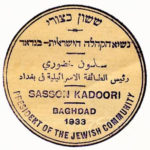 Joseph Sassoon Semah shares his lost rich Jewish Babylonian cultural heritage through art, performances and debates. He asks the public to review their own art, culture, traditions and identity.
Joseph Sassoon Semah shares his lost rich Jewish Babylonian cultural heritage through art, performances and debates. He asks the public to review their own art, culture, traditions and identity.
The manifestation takes place mainly in 36 different public locations in Amsterdam, from September 7th 2019 – January 19th 2020.
Nederlandstalig: http://rozenbergquarterly.com/gast-wordt-gastheer/
Stichting Metropool Internationale Kunstprojecten
Curator: Linda Bouws.
On Friendship/(Collateral Damage) III – The Third GaLUT: Baghdad, Jerusalem, Amsterdam is an aesthetic and poetic research into the cities Baghdad, Jerusalem and Amsterdam, which has been conceived by artist Joseph Sassoon Semah and curated by Linda Bouws (Metropool International Art Projects). All these cities are said to have been tolerant at some time in their history, but how does that relate to ‘otherness’ and what does it mean today? The project focuses on two lines of thought. The first is what Semah called ‘The Third GaLUT’, the third Exile, a metaphor for disconnectedness.
The second is ‘The Guest’, he who is allowed to live and work in a foreign context tests his surroundings the very moment he articulates his particular position in exile without any reservations.
The Guest becomes Host. By this process Semah investigates one of the greatest achievements of human civilisation: hospitality. Joseph Sassoon Semah translates his cultural and visual heritage and its subtext into contemporary art. While doing so he reassesses and redefines lost heritages.
The project will translate the cultural heritage of Baghdad, Jerusalem, and Amsterdam, with the help of the different ‘Guests’, into a meaningful experience for a broad audience.
In On Friendship/(Collateral Damage) III – The Third GaLUT: Baghdad, Jerusalem, Amsterdam, Joseph Sassoon Semah shares his lost rich Jewish Babylonian cultural heritage and asks the public to review their own art, culture, traditions and identity. This will take place mainly in 36 public locations
in Amsterdam.
There will be new pieces of art, performances, debates, lectures, round-table discussions, video-interviews, a publication in English, articles on diverse platforms, a research – and a video-report.
Simultaneously in Amsterdam, Baghdad and Jerusalem a small house will be built: MaKOM in MaKOM. The project will translate the cultural heritage of Baghdad, Jerusalem and Amsterdam, with the help of different ‘Guests’, into a meaningful experience for a broad audience.
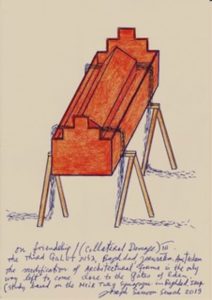 Artist Joseph Sassoon Semah
Artist Joseph Sassoon Semah
Artist Joseph Sassoon Semah was born in Baghdad (Iraq, 1948), as one of the last of a Babylonian Jewish family lineage, the grandson of Chief Rabbi Hacham Sassoon Kadoori (1885-1971). Kadoori was the head of the Babylonian Jewish community and preached of peace between Judaism, Islam and Christianity. Baghdad once was one of the most diverse an tolerant cities in the world. The Babylonian Jews in Iraq were one of the oldest and historically seen, the most important Jewish community. The Talmud Bavli was compiled in Babylon and during the British mandate in the 1920s, the well-educated Jews played an important role in public life. But from 1948, the year of independence for Israel, life for Jews in Iraq becomes extremely difficult.
Between 1950-1952, 120.000 – 130.000 Iraqi Jews were transported to Israel. The displaced Baghdadi Jews were forced to leave behind their culture and possessions in Iraq. Semah, together with his parents was displaced to the State of Israel in 1950. His grandfather Hacham Sassoon Kadoori refused to leave Iraq and stayed in Bagdhad until his death. His experiences in the Six Day War (1967) and the Yom Kippur War (1973) resulted in Joseph Sassoon Semah deciding to leave Israel: in this context he calls this a self-imposed exile.
As a Babylonian Jew who emigrated to the West (Amsterdam), he is part of GaLUT (Exile), an endless cycle of diaspora and return. You long for your country of birth and search for a way to relate to your cultural heritage and traditions. Heritage reminds us of our history.
On Friendship/(Collateral Damage) III – The Third GaLUT: Baghdad, Jerusalem, Amsterdam
For this project Joseph Sassoon Semah designs a new series of drawings and scale-sized architectural models of houses, cultural institutions, synagogues and Jewish burial places in Baghdad from before 1948, that refer to their rich history.
At all 36 locations there will be an architectural art-model on show for at least a month, and activities will be organised with the partners.
On Friendship/(Collateral Damage) III – The Third GaLUT: Baghdad, Jerusalem, Amsterdam was realised in part with the support of AFK, BPD Cultuurfonds, Lumen Travo Gallery, Mondriaan Fonds and Redstone Natuursteen & Projecten.
Please mark the following data in your calendar and keep an eye out for our next newsletters or stay up-to-date at http://rozenbergquarterly.com/category/meritis_makom/ and www.josephsemah.nl
On Friendship/(Collateral Damage) III – The Third GaLUT: Baghdad, Jerusalem, Amsterdam will take place in 36 places:
1. Location: Lumen Travo Gallery, Lijnbaansgracht 314, Amsterdam
Date: 7 September – 26 October 2019
Exhibition, performance and meetings, opening 7 September, 17.00 hrs.
On Saturday 7 September at 5 pm: opening of On Friendship / (Collateral Damage) III – The Third GaLUT: Baghdad, Jerusalem, Amsterdam.
Performance: Joseph Sassoon Semah, Baruch Abraham, Peter Baren, Zuhal Gezik, Jom Semah.
Exhibition: drawings from the new series ‘Between Graveyard and Museum’s sphere’, paintings, sculptures and a model cast in bronze of the Meir Tweig Synagogue of Hacham (Chief Rabbi) Sassoon Kadoori, who was also president of the Babylonian community in Iraq.
He lived from 1885-1971. Artist Joseph Sassoon Semah is his grandson. The model, key work of the project, will later be exhibited at other locations.
Lumen Travo Gallery, the gallery of Joseph Sassoon Semah, is the home of the entire event.
A space is also available as an information and research place and ad hoc lectures and meetings are organized for a small audience.
2. Location: Advocatenkantoor Bynkershoek, Herengracht 310, Amsterdam
Date: 24 September – 6 October 2019
Art and private meeting 24 September, 18.00 hrs.
3. Location: Goethe-Institut Amsterdam, Herengracht 470, Amsterdam
Date: 12 September – 12 October 2019
Lecture & Performance, 12 September, 20.00 hrs.
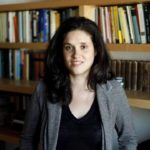 Lecture: dr. Yael Almog, Goethe Universität Frankfurt
Lecture: dr. Yael Almog, Goethe Universität Frankfurt
The lecture will engage with the presentation of the East in the works of the great German poet Johann Wolfgang von Goethe particularly in his major work on Eastern aesthetics, the West-Östlicher Divan. In his Divan, Goethe portrays the possibility of cultural exchange through art between the East and the West. What was the meaning of this vision in Goethe’s time? How can we understand the West-östlicher Divan in light of contemporary polemics on migrants and refugees? The Israeli migration to Western Europe will be taken as a unique case study with which to examine the contemporary validity of Goethe’s vision.
Performance:
Joseph Sassoon Semah, Baruch Abraham, Levent Aslan and Zuhal Gezik – Aslan Muziekschool with 6 students, Dali Heymann, Uzi Heymann, Atousa Bandeh, Peter Baren, Mikko Fritze, Jom Semah, Yvonne Strang and Els Wijnen.
Kunstmanifestatie On Friendship/(Collateral Damage) III – The Third GaLUT: Baghdad, Jerusalem, Amsterdam ~ Gast wordt Gastheer
 Kunstmanifestatie in Amsterdam door stichting Metropool Internationale Kunstprojecten
Kunstmanifestatie in Amsterdam door stichting Metropool Internationale Kunstprojecten
Joseph Sassoon Semah deelt zijn verloren gegane culturele erfenis door middel van beeldende kunst, performances, debatten en lezingen. De manifestatie vindt plaats op 36 verschillende locaties in Amsterdam, van 7 september 2019 tot en met 19 januari 2020.
Stichting Metropool Internationale Kunstprojecten
Curator: Linda Bouws.
The Introduction in English: http://rozenbergquarterly.com/the-guest-becomes-host/
On Friendship/(Collateral Damage) III – The Third GaLUT: Baghdad, Jerusalem, Amsterdam is een poëtische en kritische zoektocht van kunstenaar Joseph Sassoon Semah naar de steden Amsterdam, Bagdad en Jerusalem. Deze steden waren van oudsher gastvrije en tolerante toevluchtsoorden. Zijn ze dat vandaag nog? Wat is de plek voor ‘De Gast’, degene die in een vreemde context leeft en werkt en zijn omgeving toetst op het moment dat hij zijn specifieke positie als ’Gast’ in ballingschap zonder enig voorbehoud toont en zijn plaats opeist? De Gast wordt Gastheer. Deze bijzondere kunstmanifestatie gaat over twee onlosmakelijke grootheden: de dynamiek van de derde ballingschap en de evolutie van Gast naar Gastheer.
Joseph Sassoon Semah ontwerpt voor de manifestatie 36 architecturale modellen op schaalgrootte van huizen, culturele instituties, synagogen, joodse begraafplaatsen in Bagdad van voor 1948, die refereren aan de rijke geschiedenis van zijn verloren gegane joodse Babylonische cultuur, en een nieuwe serie tekeningen. Hij vraagt het publiek opnieuw te kijken naar zijn eigen kunst, cultuur, tradities en identiteit.
De manifestatie vindt plaats op 36 zeer diverse locaties van musea tot fietswinkel, van theaters tot hotel, van schaakwinkel tot garage. Op alle plekken verschijnt zijn kunst en worden met de partners activiteiten georganiseerd (artistieke interventies, performances, lezingen, en debatten). Daarnaast bouwen wij een huis in Amsterdam (Hermitage Amsterdam), in Bagdad (voor de synagoge Meir Tweig) en in Jeruzalem (Jerusalem Biënnale): MaKOM in MaKOM.
On Friendship/(Collateral Damage) III – The Third GaLUT: Baghdad, Jerusalem, Amsterdam’ is mede tot stand gekomen met steun van AFK, BPD Cultuurfonds, Lumen Travo Gallery, het Mondriaan Fonds en Redstone Natuursteen & Projecten.
 Over de kunstenaar Joseph Sassoon Semah
Over de kunstenaar Joseph Sassoon Semah
Joseph Sassoon Semah is geboren in Bagdad (Irak, 1948) als één van de laatsten van de Babylonische joodse familielijn, de kleinzoon van Hacham (chief-rabbi) Sassoon Kadoori (1885-1971). Kadoori was de president van de Babylonische gemeenschap en predikte vrede tussen het jodendom, de islam en christendom. Bagdad was een van de meest diverse plaatsen ter wereld. Vanaf 1948, het jaar van de onafhankelijkheid van Israël, hebben de Iraakse joden het echter zwaar. Tussen 1950-1952 werden 120.000 -130.000 van de joodse gemeenschap van Irak naar Israël getransporteerd. De ontheemde Bagdadi-joden werden gedwongen hun cultuur en bezit in het Midden-Oosten te verlaten. Samen met zijn ouders werd Joseph Sassoon Semah in 1950 ‘verplaatst’ naar de staat Israël. Zijn grootvader Hachem Sassoon Kadoori weigerde Irak te verlaten en bleef tot zijn dood in Bagdad. Ervaringen in de Zesdaagse Oorlog (1967) en de Yom Kippur Oorlog (1973) deden Joseph Sassoon Semah besluiten Israël te verlaten: in deze context spreekt hij van een ‘zelfopgelegde ballingschap’.
Als Babylonische jood die is geëmigreerd naar het Westen (Amsterdam) is hij onderdeel van GaLUT (Exile), een eindeloze cyclus van diaspora en terugkeer. Je blijft altijd verlangen naar je geboorteland en zoekt een manier om je te verhouden tot je culturele erfenis en tradities. In Irak zelf is geen enkele herinnering meer aan de eens zo machtige joodse Babylonische gemeenschap. De Babylonische cultuur is driemaal vernietigd: in Irak, in Israël, maar ook in Europa speelt ze nauwelijks nog een rol. Alhoewel er geen joden meer leven in Irak en de Babylonische cultuur lang is ondergeschoven in Irak, Israël en in Europa, kan hun cultuur niet langer worden genegeerd. Een terugkeer naar de cultuur en identiteit die ze in Irak, Israël en Europa hebben verloren.
Joseph Sassoon Semah spreekt van ‘architectuur in ballingschap’.
In On Friendship/(Collateral Damage) III – The Third GaLUT: Baghdad, Jerusalem, Amsterdam onderzoekt Joseph Sassoon Semah hoe verloren gegane culturele erfenis weer betekenis kan krijgen. Hij vertaalt zijn verloren gegane, rijke joodse Babylonische culturele erfgoed in beeldende kunst en performances. Terwijl hij dat doet revalueert en herdefinieert hij dit erfgoed samen met anderen. Zijn gasten.
Activiteiten en Locaties: On Friendship/(Collateral Damage) III – The Third GaLUT: Baghdad, Jerusalem, Amsterdam Kunstmanifestatie van 7 september 2019 t/m 19 januari 2020
Op elke locatie verschijnt voor een maand een ander architecturaal model en een selectie uit de serie nieuwe tekeningen.
Locaties: Joods Historisch Museum – Nieuwe Amstelstraat 1 Amsterdam – en Redstone Natuursteen & Projecten – Benit 18 Amsterdam
Datum: 20 december 2019 t/m 19 januari 2020)
In het Joods Historisch Museum en bij Redstone Natuursteen & Projecten worden gelijktijdig twee identieke kunstwerken opgesteld. De vorm van de objecten is gebaseerd op de herinnering die kunstenaar Joseph Sassoon Semah heeft aan de ingang van een publieke schuilkelder in Tel Aviv.
Tussen de twee objecten in (tussen de Publieke en Private Ruimte) heeft hij een onzichtbaar Zwart Vierkant bestemd – een onzichtbaar gebied – een gemoedstoestand – een ruimtelijke plaats – een zekere leegte – een herinnering aan מקלט עיר IER MiKLaT & Het Toevluchtsoord / Schuilkelder &
Performance & bijeenkomst: 16 januari, aanvang 14.00 uur
In het kader van de manifestatie vindt op 16 januari 2020 vanaf 14 uur een gesprek plaats, voorafgegaan door een performance.
Performance: Joseph Sassoon Semah met 22 participanten: o.a. Emile Schrijver, Baruch Abraham, Jom Semah, Peter Baren, Uzi Heymann, Bulent Evren, Mudar Adas, Yvonne Strangen, Zuhal Gezik en Renée Hartog.
Gesprek: Emile Schrijvers (algemeen directer JCK), Arie Hartog (directeur Gerhard-Marcks Haus, Bremen) en Joseph Sassoon Semah over de urgentie van diversiteit in het jodendom en de noodzaak van heroriëntatie van culturele erfenis in musea.
Voor nadere informatie en aanmeldingen verwijzen wij u naar www.jck.nl.
Zie voor info tentoonstelling in het Joods Historisch Museum: https://jck.nl/nl/tentoonstelling/friendshipcollateral-damage-iii-third-galut-baghdad-jerusalem-amsterdam
Op 36 locaties in Amsterdam zijn unieke architecturale modellen van huizen, synagogen, culturele instituties, joodse begraafplaatsen in Bagdad van voor 1948 geplaatst, die refereren aan de geschiedenis van Joseph Sassoon Semahs verloren gegane rijke joodse Babylonische cultuur. In december en januari zijn op de volgende locaties de modellen op schaalgrootte te bezichtigen.
Achsa Vissel ~ Tijd voor andere verhalen
NIW 27 november 2019
